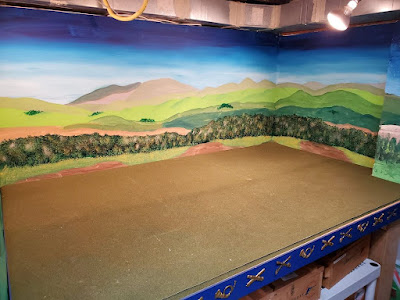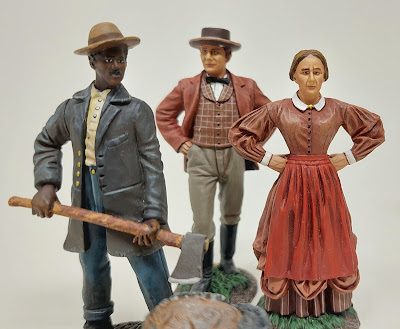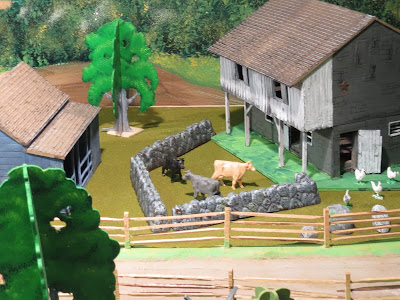"My men fell around me like dead flies on a frosty morning." Officer in Dana's brigade
"The thundering of artillery, the roaring of bursting shells, the rolling of musketry, and humming of deadly fragments and bullets. and sometimes the yells of the rebels and our own cheers all seemed to fill the whole horizon and drive peace away forever."
Thomas Livermore
-----
Editor's notes: Historians almost universally divide the Battle of Greenbrier into three distinct phases; the great meadow phase, the rocky upland phase, and the walled pasture phase. This narrative will follow that practice.
Federal artillery was the determining factor of the battle; sixty guns in ten six-gun batteries were brought to the field. Of note is that five of the Union batteries were regular army artillery. The Confederates had a paucity of guns; sixteen guns in four four-gun batteries, furthermore 25% of their guns were obsolete smooth-bore six-pounders whereas the Federal batteries had a majority of rifled 3" ordnance rifles with a range of up to two miles at great accuracy.
The artillery of both sides made very effective use of canister. Canister is a projectile that consists of 28 one-and-one-half inch diameter iron balls packed, with sawdust, into a light tin canister. Effective at ranges under 400 yards, canister turns a cannon into a giant sawed-off shotgun and has devastating results upon the troops against whom it is deployed.
Confederate general Ambrose Powell Hill referred to the Battle of Greenbrier as "Yankee artillery's finest hour."
-----
It is seven o'clock in the morning April 17th,1862 three miles to the west of Greenbrier Maryland in the Cumberland Valley. The Third Division of the Third Corps, Army of the Potomac, under Major General Alpheus Williams has been dispatched to intercept the combined divisions of Confederate General A.P. Hill, and John Bell Hood of the Army of Northern Virginia. The Federals have approached the field from the southeast and the Confederates from the southwest.
The great meadow phase: 7:00 - 10:00 am.
On the northern end of the battlefield lies a fifteen-acre meadow. The battle, which was to have been joined at first light was delayed until the dense fog lifted and the proceedings got underway only at seven a.m.
"...a great tumbling together of all heaven and earth - the slaughter on both sides was enormous." Private, 6th Wisconsin
Volley fire continues for nearly twenty minutes with neither side showing any sign of weakening. The opposing lines are equally matched and neither can find an advantage to dislodge the other.
"The fire now became fearful and incessant...merged into a tumultuous chorus that made the earth tremble a thousand distant drums..." Felix de Fontaine Charleston Daily Courier
"Very soon our Reg was under fire the balls whisin [sic] over us...I commenced loading and shooting with all my might but my gun got chooked [sic] the first round, and I picked up a gun of one of my comrades who fell by my side and continued to fire...I do not know whether I killed any one or not." Private Calvin Leach, 1st North Carolina.
It begins to appear to the opposing commanders that there will be no decisive moment in the contest as neither side wavers.
Suddenly, the jingle of harness and rumble of limbers heralded the arrival of that which would tip the balance.
Guns are man-handled into battery, horses are led to the rear, and limber chests are hurriedly attended to.
Lanyards are stretched taut...
"Fire!"
The ground shook as the guns swept through the rebel ranks.
It was only after the Confederates are flanked by Union artillery, while under sustained fire to their front, do they finally - after nearly two hours of fighting - retire in some haste from the field.
Thus ended the short, but sharp, "Great Meadow" phase. The victorious, but severely battered, Federals retain the field, consolidate their position, and await developments.
The rocky upland phase: 9:30 am - 1:00 pm.
The center of the Confederate line - the "rocky upland" is a very strong defensive position. Although the Confederates are holding the ground with only two depleted regiments, they are initially successfully holding owing to the advantage provided by the rocky slopes, and natural defensive positions.
The fire at this range exacts minimal casualties on either side though the Federals suffer a higher percentage of killed and wounded.
Union commanders recognize the advantage of the strong rebel position and are reluctant to mount a direct assault but opt for infantry volley fire at a very long range of 375 yards
.
The Confederates, though outnumbered, take every advantage of their superior , with its natural rifle-pits and breastworks provided by the many boulders.
Below, the Federals form behind the scant shelter of a low stone wall.
A little over ninety minutes into the exchange four batteries of Federal guns deploy at a distance of one mile and open fire with bolt and case shot. The results of the shrapnel from the case and the showers of rock fragments from the bolts exact a heavy toll on the two small rebel regiments.
A battery of Federal rifled guns zeros in the Rebel stronghold.
"The enemy fell like grass before the mower...it seemed as if whole companies were wiped out of existence." Major Orrin Crane, 7th Ohio.
"...legs, arms, and other parts of human bodies were flying in the air like straw in a whirlwind. The dogs of war were loose, and 'havoc' was their cry." Soldier, 4th Texas.
For nearly two hours the valiant rebels absorb the blows as casualties mount. By 12:30 pm the 1st regiment of United States Sharpshooters ("Berdan's") flank the Confederate left, making their position untenable and the desperate defenders are driven in disarray from the heights. Federal's advance to the former Confederate positions and hold that portion of the field for the remainder of the day.
The walled pasture phase: 2:30 - 5:30 pm.
The walled pasture phase sees Union and Confederate firing lines at a mere 100 yards distant from each other. On the northern side of the pasture are two Confederate regiments - the 2nd Mississippi and the 17th Virginia. On the southern end of the field are the veteran 3rd Michigan and the rookie 17th Maine. This will be a close-quarters fight.
The 3rd Michigan arrives on the field.
The "long roll" signals that battle is imminent.
Movement is seen in the woods beyond the pasture.
The veterans of the 17th Virginia are taking up position.
"Hooker's men were fully up to their work, they saw their General every where in the front, never away from the fire, and all the troops believed in their commander and fought with a will." George Smalley New York Tribune.
Firing commenced around 3:00 with both sides sustaining numerous casualties at such short range. After two volleys the order was given to fire by company, then by file, and finally to "fire at will". The firing continued for forty minutes with neither side gaining advantage.
The order rings out - "Commence firing!"
" The two battle lines, scarcely fifty yards apart, erupted in sheets of flame and smoke." Private Alexander Hunter, 17th Virginia
"The truth is, when bullets are whacking against tree trunks and solid shot are cracking skulls like eggshells, the consuming passion in the breast of the average man is to get out of the way." Soldier, 9th New York
On his own and without orders, the inexperienced commander of the 17th Maine, Colonel Warren West, desiring to force the issue, ordered his regiment forward. As the men from Maine advanced they were met with withering musket fire delivered from the men of the 2nd Mississippi, yet still they advanced.
Even the jaded veterans from Michigan look on in slack-jawed disbelief as the rookie 17th Maine, without support, leaves the firing line and advances toward the enemy.
"The total disregard of all ordinary military precaution in their swift and solitary advance was so manifest that it was observed and criticized as the devoted band moved on." Francis W. Palfrey, 20th Massachusetts.
About five minutes before the 17th stepped off a section (two guns) of Confederate artillery arrive and deploy beside the Mississippians. "Double canister" is ordered and the rebel twelve-pounders open a devastating fire in the faces of the faltering Federals.
Confederate gunners load double canister and open fire immediately.
"Men, I can not say fell; they were knocked out of the ranks by the dozens..."
Major Rufus Dawes, 6th Wisconsin
"...brought down the enemy as grain falls before a reaper."
Colonel F.M. Parker, 30th North Carolina
Colonel West's ill-conceived effort was broken, and his men, in full and disorganized retreat, took refuge behind the lines of the 3rd Michigan, much shaken and of little use for the remainder of the engagement.
The chaotic retreat of the 17th Maine is halted only by the stalwart lines of the Men from the Wolverine state.
Hoping to capitalize upon the disarray and confusion of his enemy, Colonel John M. Stone of the 2nd Mississippi ordered a counterattack on the heels of the fleeing 17th Maine, but by this time Union artillery had taken the field.
The men of the 2nd Mississippi advance.
The 3rd Michigan delivers a blistering volley of accurate fire.



























































































































































































